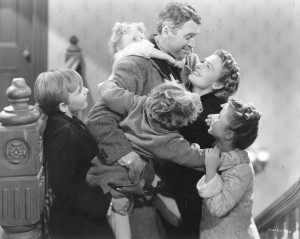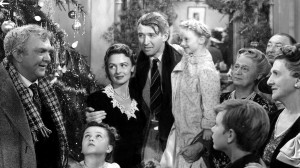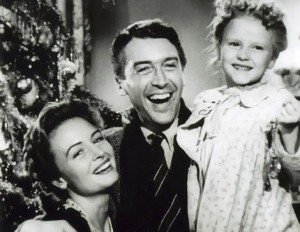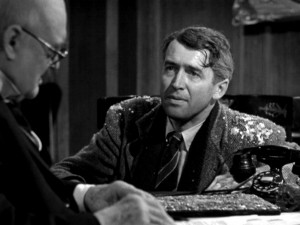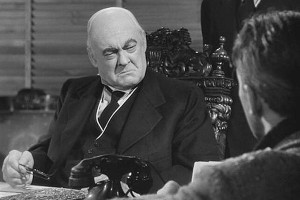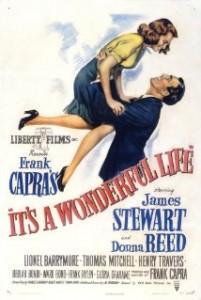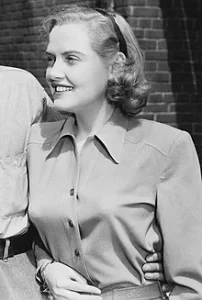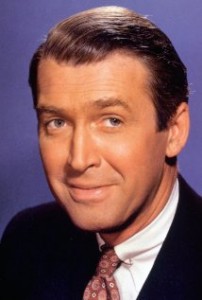It’s a Wonderful Life ***** (1946, James Stewart, Donna Reed, Henry Travers, Lionel Barrymore, Thomas Mitchell) – Classic Movie Review 9
Frank Capra’s big-hearted and richly enjoyable 1946 toast to the virtues and joys of small-town America and Americans, It’s a Wonderful Life, is now established firmly as an all-time great.
Co-writer/ producer/ director Frank Capra’s big-hearted and richly enjoyable 1946 toast to the virtues and joys of small-town America and Americans, It’s a Wonderful Life, is now established firmly as an all-time great. Its attack on the evils of greedy banks and heartless bankers remains as timeless as the movie itself. Indeed, it seems more relevant than ever. It was nominated for five Oscars.
In both his favourite film and favourite role, James Stewart gives one of his most shrewdly judged and iconic performances as George Bailey, a despairing businessman who contemplates suicide but is saved by his cuddly guardian angel Clarence (Henry Travers, adorable), who shows him how terrible life in his (fictional) town of Bedford Falls would have been if he had never lived.
Mean old financier Mr Potter is planning to take over the town, but Stewart’s small-scale loan firm is firmly in the way. That is, at least until his sweet but irresponsible Uncle Billy loses the business’s money that he is supposed to be putting in the bank, money that is found by Potter of course. When the auditor finds out, Stewart will go to jail, his company will go bust and Potter will win!
Perennial Christmas TV favourite It’s a Wonderful Life has earned its place over the years as one of the finest feel-good movies ever made, thanks to the lovely performances, genuine sentiment and the tender loving care that has gone into crafting the marvellous production. The wonderful moral tale, told in flashback, is based on a short story, The Greatest Gift, which author Philip Van Doren Stern apparently first penned one year on his Christmas cards.
The special cast comes complete with the most charismatic of star turns from Lionel Barrymore as Mr Potter the miserable banker, Thomas Mitchell as Stewart’s hard-drinking Uncle Billy, and Donna Reed as his true love Mary Hatch.
Also in the cast are Beulah Bondi, Frank Faylen, Gloria Grahame, H B Warner, Samuel S Hinds, Ward Bond, Frank Albertson, Mary Treen, Ellen Corby, Sheldon Leonard, Virginia Patton as Ruth Dakin Bailey, Charles Williams, Sarah Edwards, Bill Edmunds, Lillian Randolph, Bobby Anderson, Danny Mummert, George Nokes, Ray Walker, Charles Lane, Edward Keane, Bobby Scott, Hal Lindon, Carl Switzer, Harry Holman, Harry Cheshire, Marion Carr, Lane Chandler and Almira Sessions.
It’s a Wonderful Life is directed by Frank Capra, runs 129 minutes, is made by Liberty Films, is released by RKO Radio Pictures, is written by Frances Goodrich (screenplay), Albert Hackett (screenplay) and Frank Capra (screenplay) and Jo Swerling (additional scenes), based on the short story The Greatest Gift by Philip Van Doren Stern, is shot in black and white by Joseph Walker and Joseph F Biroc, is produced by Frank Capra and Jo Swerling, is scored by Dimitri Tiomkin and designed by Jack Okey and William Cameron Menzies (uncredited).
Set at Christmas, it was filmed in a heatwave and it could be 90 degrees on set, so you can see Stewart sweating in the snow: ah the magic of the movies! Snow was created using 6,000 gallons of a mix of fire-fighting chemical foamite, soap and water pumped at high pressure through a wind machine. The town set took two months to build and spread over four acres, with 75 buildings constructed.
Such troubles led it to be a hugely costly film at a budget of $3,180,000, and, though it was successful at the box office, it was not profitable. With the budget of $3.18 million, the box office take was $3.3 million, yet it recorded a loss of $525,000 for RKO.
And not only was it a box-office disappointment, it was also an awards disappointment, as it was released a week after the sensationally successful The Best Years of Our Lives, which swept the board at the Oscars, leaving It’s a Wonderful Life empty handed after five nominations. It is weird how time has totally changed the perspective on these two films.
In 1947, the FBI said ‘the film represented rather obvious attempts to discredit bankers by casting Lionel Barrymore as a ‘Scrooge-type’ so that he would be the most hated man in the picture. This is a common trick used by Communists’.
The film has been colorised three times and, it might be heretical to say so and an insult to Joseph F Biroc’s luminous black and white cinematography, but it works beautifully like this. The first colorised version was produced by Hal Roach Studios (now Hallmark Entertainment), the second by Republic Pictures and the third by Legend Films for Paramount, the film’s current copyright holder, in 2007.
Capra won the Golden Globe for Best Motion Picture Director. There were five Oscar nominations (Best Picture, Best Actor, Best Director, Best Sound Recording, Best Film Editing) but no wins.
A clerical error at National Telefilm Associates, who then owned the rights, prevented the copyright from being renewed properly in 1974. But, though the film’s images had entered the public domain, the film’s story was still restricted as a derivative work of the published story The Greatest Gift, whose copyright Philip Van Doren Stern had renewed in 1971.
The film was restored in 4K resolution in 2017, available via streaming services.
Virginia Patton died on 18 August 2022, aged 97. She appeared in several films in the early 1940s, before her best-known role as Ruth Dakin Bailey in It’s a Wonderful Life. She made only four more films, including her first lead in the B-Western Black Eagle (1948) and the Ku Klux Klan drama The Burning Cross (1946), but retired from acting after The Lucky Stiff (1949) to raise a family.
James Stewart classics include The Philadelphia Story, Vertigo, Mr Smith Goes to Washington, Rear Window and Anatomy of a Murder.
http://derekwinnert.com/vertigo-classic-film-review-48/
http://derekwinnert.com/rear-window-classic-film-review-49/
http://derekwinnert.com/anatomy-of-a-murder-classic-film-review-59/
© Derek Winnert 2013 Classic Movie Review 9
Link to Derek Winnert’s home page for more film reviews: http://derekwinnert.com/

